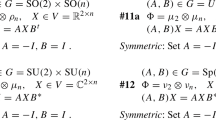Abstract
One of the most central and controversial element of quantum mechanics is the use of non zero vectors of a Hilbert space (or, more generally, of one dimension subspaces) for representing the state of a quantum system. In particular, the question whether such a representation is complete has been debated since almost the early days of quantum mechanics.
In this article, we develop an alternate way to formalize knowledge about the state of quantum systems, based solely on experimentally accessible elements, namely on outcomes of finite measurements. We introduce what we call partial description which, given a feasible measurement, indicates some outcomes which are known to be impossible (i.e. known to have a probability equal to 0 to occur) and hence have to be discarded. Then, we introduce partial states (which are partial descriptions providing as much information as possible) and compare this way to describe quantum states to the orthodox one, using vector rays.
Finally, we show that partial states allow to describe quantum states in a strictly more expressive way that the orthodox description does.
Similar content being viewed by others
References
Bell, J.S.: On the Einstein-Podolsky-Rosen paradox. Physics 1, 195–200 (1964)
Bell, J.S.: Speakable and Unspeakable in Quantum Mechanics. Cambridge University Press, Cambridge (1987)
Birkhoff, G.: Lattice Theory, 3rd ed. Colloquim Publications, American Mathematical Society, Providence (1967)
Brunet, O.: A priori knowledge and the Kochen-Specker theorem. Phys. Lett. A 365(1–2), 39–43 (2007)
Dalla Chiara, M.L., Giuntini, R.: Quantum logic. In: Gabbay, D., Guenthner, F. (eds.) Handbook of Philosophical Logic, vol. III. Kluwer, Dordrecht (2001)
Davey, B.A., Priestley, H.A.: Introduction to Lattices and Order. Cambridge Mathematical Textbooks (1990)
Einstein, A., Podolsky, B., Rosen, N.: Can quantum-mechanical description of physical reality be considered complete? Phys. Rev. 47, 777–780 (1935)
Gleason, A.: Measures on the closed subspaces of a Hilbert space. J. Math. Mech. 6, 885–893 (1957)
Gratzer, G.: General Lattice Theory. Academic, New York (1978)
Hughes, R.I.G.: The Structure and Interpretation of Quantum Mechanics. Harvard University Press, Cambridge (1989)
Kochen, S., Specker, E.P.: The problem of hidden variables in quantum mechanics. J. Math. Mech. 17, 59–87 (1967)
Pták, P., Pulmannová, S.: Orthomodular Structures as Quantum Logics. Kluwer, Dordrecht (1991)
Smets, S.: On causation and a counterfactual in quantum logic: the Sasaki hook. Log. Anal. 173–175 (2001)
Stubbe, I., van Steirteghem, B.: Propositional systems, Hilbert lattices and generalized Hilbert spaces. In: Engesser, K., Gabbay, D.M., Lehmann, D. (eds.) Handbook of Quantum Logic and Quantum Structures: Quantum Structures, pp. 477–524. Elsevier, Amsterdam (2007)
Author information
Authors and Affiliations
Corresponding author
Rights and permissions
About this article
Cite this article
Brunet, O. Partial Description of Quantum States. Int J Theor Phys 48, 729–742 (2009). https://doi.org/10.1007/s10773-008-9849-0
Received:
Accepted:
Published:
Issue Date:
DOI: https://doi.org/10.1007/s10773-008-9849-0




